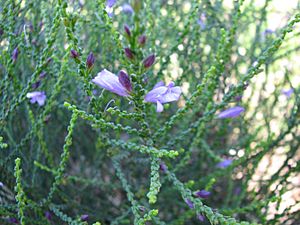Coccid emu-bush facts for kids
Quick facts for kids Coccid emu-bush |
|
|---|---|
 |
|
| Eremophila gibbifolia in the Royal Botanic Gardens, Melbourne. | |
| Scientific classification | |
| Genus: |
Eremophila (plant)
|
| Species: |
gibbifolia
|
| Synonyms | |
|
|
Eremophila gibbifolia, also called the coccid emu-bush, is a beautiful flowering plant. It belongs to the figwort family, called Scrophulariaceae. This plant is special because it is only found in Australia, meaning it is endemic there. It's a small, rare shrub that grows naturally in Victoria and South Australia. You can spot it by its small, thick, bumpy leaves and pretty lilac to purple flowers with spots inside.
Contents
What Does the Coccid Emu-Bush Look Like?
The coccid emu-bush is a shrub that usually grows less than 0.9 m (3 ft) tall. It has many green branches that crisscross and are covered in fine hairs.
Leaves of the Emu-Bush
Its leaves are arranged one after another along the stem. They are usually 1.5–5 mm (0.06–0.2 in) long and 1–2 mm (0.04–0.08 in) wide. The leaves are thick, fleshy, and smooth (meaning they have no hairs). They are shaped like an oblong or a heart. These leaves often press against the stem. They have one or two pairs of large, warty bumps. The edges of the leaves also have many smaller raised bumps.
Flowers of the Emu-Bush
The flowers grow one by one where the leaves meet the stem. Each flower sits on a short stalk, less than 1.5 mm (0.06 in) long. There are 5 narrow, pointed green sepals, which are 2–4 mm (0.08–0.2 in) long. The petals are 7–10.5 mm (0.3–0.4 in) long. They are joined at the bottom to form a tube shape.
The flowers are usually a shade of lilac to purple. The tips of the petals are lilac, but the inside of the tube is white with mauve or brown spots. The outside of the flower is smooth. However, the inside surface of the bottom petal has long hairs down its middle. The inside of the tube is also full of long hairs. Two stamens (the parts that make pollen) are hidden inside the petal tube. The other two stick out a little bit. After the flower, the plant produces fruits that are somewhat cylinder-shaped and slightly flat. They are 2–3.5 mm (0.08–0.1 in) long.
How the Coccid Emu-Bush Got Its Name
The coccid emu-bush was first officially described in 1855. A scientist named Ferdinand von Mueller gave it the name Duttonia gibbifolia.
Changing Names for Plants
In 1859, Mueller moved the plant to a different group, or genus, called Eremophila. He did this because the name Duttonia was already being used for another plant group in the daisy family, Asteraceae. That group is now known as Syncarpha.
Meaning of the Plant's Name
The second part of its scientific name, gibbifolia, comes from Latin words. Gibbus means "humpbacked" or "bumpy". Folium means "a leaf". So, gibbifolia describes the plant's leaves, which have hump-like bumps. The common name, coccid emu bush, comes from an Ancient Greek word kókkos, which means "grain" or "seed".
Where Does the Coccid Emu-Bush Grow?
E. gibbifolia is found in a few areas of South Australia. These include the Eyre Peninsula, Southern Lofty, South East, and Murray botanical regions. It also grows in western parts of Victoria. In both states, it prefers to grow in powdery clay or sandy soil. You can often find it in mallee scrub areas.
Is the Coccid Emu-Bush Endangered?
This plant is considered "rare" in both South Australia and Victoria. This means there are not many of them left in the wild.
Growing Coccid Emu-Bush in Gardens
The tiny, bumpy leaves of this emu-bush make it a unique and interesting plant for gardens. It's a great choice for a small garden or even for growing in a pot. You can grow new plants from cuttings. However, it might grow better if it is grafted onto a Myoporum rootstock. This plant can handle dry conditions and frost once it's fully grown. Giving it a light trim now and then helps it stay in a nice, compact shape.

